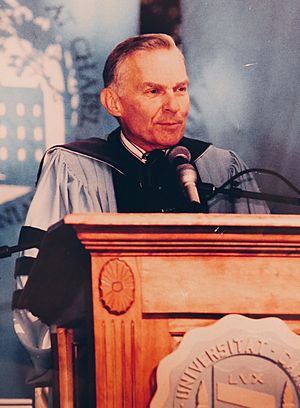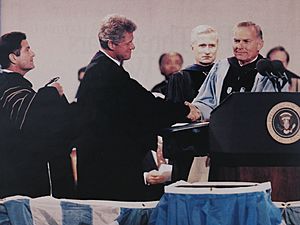Paul Hardin III facts for kids
Quick facts for kids
Paul Hardin III
|
|
|---|---|

Paul Hardin III, Chancellor of the University of North Carolina at Chapel Hill, addresses the UNC community on University Day, 1993.
|
|
| 7th Chancellor of the University of North Carolina at Chapel Hill | |
| In office 1988–1995 |
|
| Preceded by | Christopher Columbus Fordham |
| Succeeded by | Michael Hooker |
| President of Wofford College | |
| In office 1968–1972 |
|
| Preceded by | Charles Franklin Marsh |
| Succeeded by | Joab Mauldin Lesesne Jr. |
| President of Southern Methodist University | |
| In office 1972–1974 |
|
| Preceded by | Willis M. Tate |
| Succeeded by | James Zumberge |
| President of Drew University | |
| In office 1974–1988 |
|
| Personal details | |
| Born | June 11, 1931 Charlotte, North Carolina, U.S. |
| Died | July 1, 2017 (aged 86) Chapel Hill, North Carolina, U.S. |
| Alma mater | Duke University |
| Occupation | Lawyer |
Paul Hardin III (born June 11, 1931 – died July 1, 2017) was an American leader in higher education. He spent 27 years helping to guide colleges and universities. He was the chancellor of the University of North Carolina at Chapel Hill from 1988 to 1995. Before that, he was president of Wofford College (1968–1972), Southern Methodist University (1972–1974), and Drew University (1974–1988). Paul Hardin III studied law at Duke University.
Contents
Paul Hardin's Early Life and Learning
Paul Hardin III was born in Charlotte, North Carolina, on June 11, 1931. His father, Paul Hardin Jr., was a Methodist bishop. Paul grew up in several towns across North Carolina.
He went to Duke University for both his bachelor's degree and his law degree. At Duke, he was a top student, finishing first in his law school class. He was also the editor-in-chief of the Duke Law Journal. Outside of his studies, he played on the golf team.
In 1954, Paul married Barbara Stone Russell. They met while on vacation in the North Carolina mountains. He decided not to try for a special scholarship called a Rhodes Scholarship. He wanted to stay at Duke with Barbara. They both graduated from Duke in 1954.
After college, Paul served in the U.S. Army Counter Intelligence Corps. Then, he worked as a lawyer in Birmingham, Alabama. Later, he returned to Duke University Law School to teach. He taught there for ten years. At age 37, he became the President of Wofford College.
A Career in University Leadership
Leading Wofford College (1968-1972)
Paul Hardin became president of Wofford College in the late 1960s. This was a time when many students across the country were protesting. He was known for making the campus more open. He allowed different speakers to visit and made sure students could express their ideas freely. He also worked to end segregation at the college. He hired Wofford's first African-American administrator.
Leading Southern Methodist University (1972-1974)
After Wofford, Hardin became President of Southern Methodist University (SMU) in Dallas, Texas. During his time there, he found out about rule-breaking in the SMU football program. This involved coaches and other important people. Hardin reported these problems to the NCAA. Many people praised him for this brave decision. However, some powerful members of the university's board made him leave his job. Even after he left, the problems continued. This eventually led to the Southern Methodist University football scandal.
Paul Hardin did not see this event as a failure. He believed it helped him grow and led to a very successful career in university leadership.
Leading Drew University (1974-1988)
After leaving SMU, Hardin moved to New Jersey. There, he became the leader of Drew University. He became known for being great at raising money and for his energetic leadership. Some of his important achievements at Drew include:
- Creating the United Methodist Church Archives Center.
- Remodeling the Learning Center.
- Starting the Research Institute for Scientists Emeriti (RISE) program.
He also worked to make science programs stronger at Drew. In 1983, Drew gave a personal computer to every student. This was very new and unusual at the time.
Leading the University of North Carolina at Chapel Hill (1988-1995)
Paul Hardin had studied at Duke University, which is a big rival of the University of North Carolina (UNC). So, it seemed surprising that he would become Chancellor at UNC. But in 1988, he took on the leadership role at this large public research university. UNC was very different from the smaller private colleges he had led before. He had to get used to working in the public sector.
Hardin was hired to prepare UNC for its third century. His first big task was to lead the largest fundraising campaign in the school's history. He led this effort with great excitement. The campaign raised $440 million, which was much more than its goal of $300 million.
The university's 200th birthday celebration happened in 1993. During this event, called University Day, Hardin gave an honorary degree to President Bill Clinton.
Hardin's time at UNC also had some challenges. In 1992, students asked for a separate Black Cultural Center on campus. Hardin believed that a separate building might cause division. He suggested making the current center bigger within the existing Student Union. He said, "We want a forum, not a fortress." This disagreement led to the biggest student protests on campus since the Vietnam War era. Famous people like Rev. Jesse Jackson and filmmaker Spike Lee came to support the students.
In 1993, Hardin created a committee to study the situation. The committee decided that a separate center was a good idea. However, they agreed with Hardin that it should be a working classroom building, not a separate student union. The Sonja Haynes Stone Black Cultural Center opened in 2004.
Hardin called this period "the greatest personal anguish" of his career. He had always supported civil rights. He even ran for mayor of Durham, North Carolina, in 1967. He worried that people saw him as someone who had stopped caring about these issues. But throughout his career, he worked to support different groups and ideas on campuses.
Despite the challenges, his successes at UNC were many. When he retired in 1995, the university had more students, a healthier budget, and its endowment (money saved for the future) had more than doubled.
Paul Hardin's Legacy
Paul Hardin was a national leader in higher education. He was known for his strong leadership, his ability to raise money, his honesty, and his positive attitude. He received many honorary degrees. He also served on the boards of several companies. He was an active leader in the United Methodist Church and helped his community in many ways.
Paul Hardin was a very good golfer. He played as an amateur in the 1962 British Open. He made six holes-in-one in his life and often shot his age in golf games.
Paul Hardin III passed away at his home in Chapel Hill, North Carolina, on July 1, 2017. He was 86 years old. He died from amyotrophic lateral sclerosis, also known as ALS.


